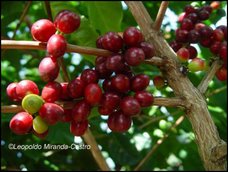©Leopoldo Miranda-Castro
Recently, I came across with Selva Negra Coffee Estate Restoration project in Nicaragua. You can find it by clicking here.
What a great project! I'm very glad that the people managing the Selva Negra Coffee Estate published this story because many people think that restoring shade coffee is as easy as 1 - 2 - 3. It is not! It takes good planning, resources, sacrifice, dedication and commitment. It is a long-term project with the main goal of reaching sustainability in every sence of the word.
In my oppinion, this is one of the best examples of how we could use shade coffee to restore many of the ecological functions of degraded areas, such as the pasture lands described in this newsletter. Touching a little bit on what I talked about in my March 2007 blog (Shade-coffee and its use as a wildlife management tool: the case of Puerto Rico), wildlife managers as well as coffee growers should focus on using these degrated habitats (e.g., pasturelands, sun coffee plantations) to expand their future activities by restoring the native shading canopy. These restores areas will provide a piece of habitat for fish and wildlife species that was not there before. At the same time, these practices could be used to eliminate the need of "taking" natural forested areas to establish new coffee plantations.
Please, take a look at their site. I'm sure you will like it. To buy some of this coffee go here.
Leo
Subscribe to:
Post Comments (Atom)



2 comments:
Leo,
What do you think the effect of climate change will be on shade grown coffee? Will farmers need to buy higher elevation land to continue cultivating Arabica, will they have to switch to Robusta, or will there be little effect in ocean-buffered climates like Puerto Rico?
Steve,
Wow, a a great question! In my oppinion the biggest challenge will be to sun coffee farmers. Shade coffee plantations are very stable ecosystems that I'm sure will adapt well to climate changes. At least in the short term. Sun coffee plantations can't adapt at all.
Going back to your question. Yes, I think that the geography of coffee will change. Although the decision to move to higher elevations or higher latitudes will need to come, the effects on climate change will depend on the local conditions of climate and weather.
The effects of oceans is very interesting. I think that the climate change may take a little longer to be felt because that "climatic buffer" On the other hand, it could increase humidity and rain over the coffee producing areas affecting their production.
Post a Comment